SXSW Interview: Charlie Hamilton James and Jeff Wilson of “Billy & Molly: An Otter Love Story”
Written by: Christopher Llewellyn Reed | March 19th, 2024
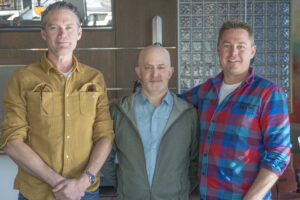
I love animal-rescue films, both short and feature-length. I am almost ashamed (but not really) to admit how much of an addict of the Dodo channel I have become. I am especially prone to watching tales of a cute animal getting a second chance at life. And now here comes Molly, an orphaned otter from Scotland’s Shetland Islands who has the good fortune to end up on the dock of a man named Billy, who sees how vulnerable she is and jumps into action. Assisted by wife Susan and Border Collie Jade, Billy manages to nurse Molly back to health. Thanks to veteran National Geographic photographer and filmmaker Charlie Hamilton James, we are right there for much of it. The resultant movie, Billy & Molly: An Otter Love Story, just premiered at SXSW 2024 (where I reviewed it), and I had the chance to speak with both James and his producer, Jeff Wilson, after watching the film. What follows is a transcript of our conversation, edited for length and clarity.
 Christopher Llewellyn Reed: What, in your opinion, makes otters so damn cute?
Christopher Llewellyn Reed: What, in your opinion, makes otters so damn cute?
Jeff Wilson: I think it’s their shape and the fact that they’re low to the ground; also their curiosity. With all of the animals that I work with, if there’s an animal that has eyes that are front-facing, then you’ve got an animal that you can engage with, and otters have that. So there’s a physics to it, but they’re also extremely, extremely friendly like Molly can be, at least when they have the right character, but not all otters are the same, right? So Molly is a very unique character. She doesn’t have that off-switch between human interaction and wild. And so I think that’s what made her such a great subject for the film.
Charlie Hamilton James: I think it’s their hands because they use their hands like we do, and they’ve got little nails on them that show, unlike cats. I think there’s something about those hands. And I think Jeff’s right about forward-facing eyes. I think they’re very appealing to us because of that.
CLR: I know that In Japan, they keep river otters as pets. As a kid, I would go to Monterey, California, and there, they have all the sea otters, which are also adorable. So can you walk me through the chain of events that led you to finding out about Molly and deciding how to make the movie?
CHJ: Well, let me just prefix that by saying they make terrible pets and it’s a big problem in Asia at the moment because they’re becoming trendy as pets and it’s not a good thing. But about me and the film, I started going to Shetland when I was 16, eventually moving there when I was 19 just to photograph and film wild otters, and it’s quite a small place and I spent most of my time in one part of the island. And 30 years later, my buddy, who I knew back then, phoned me up because he was building Susan and Billy’s house and he said, “You’ve got to come and see this otter.” And so I went up to see it just because it sounded like such a unique opportunity and discovered this amazing situation and then became friends with Billy and Susan. So it came from connections, but also my lifelong obsession with otters.
CLR: Jeff, how did you get involved?
JW: So, when Charlie got the phone call, he came down to Bristol and Silverback Films, whom I work for, and talked to a colleague of ours, Keith Scholey, and Keith put us in a room in a coffee shop and said, “Look, you guys need to talk. There’s something here.” And then Charlie and I bonded over wanting to tell a story that wasn’t a wildlife story but was more thematic than that; we wanted to tell a story about love and we wanted it to be fairytale-esque. And this had all the parts that allowed us to kind of shape the things that we want people to take away from the experience of the natural world because, of course, our jobs normally are to go and embed ourselves in wild places, and we experience the natural world very differently than most people, but the takeaways from that are what we want to pass on to our audience. And this just had all the right bits, and that’s how we started.
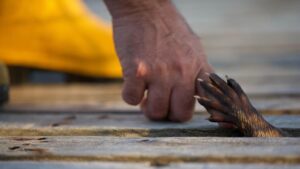
CLR: Had you been to the Shetlands before, Jeff?
JW: Never. No. I’m not even British. I’ve worked an awful lot in the Arctic, but not Shetland.
CLR: So as much as this is about Molly and her relationship to Billy, you also have another animal in the film, Jade, the Border Collie, whom we see often looking forlorn, sometimes off to the side, wanting someone to throw a ball for her. What process did you come up with in terms of including Jade and including that dream sequence of hers that you have at one point, which was so funny?
CHJ: From very early on, Jade was a central character in the film, central mainly by her absence of doing anything other than looking at a ball. So she immediately becomes this very strong character, even though she doesn’t do anything. And I think Jeff and I very early on realized the value of Jade as this sort of foil to everyone else’s serious … there are these serious messages going on in the film and there’s joy and there are all these different things, but then there’s this foil of always diverting back to Jade just looking for someone to kick her ball. And because she is so myopic, the dream sequence was kind of born out of that. We wondered, because we’d watch her dreaming, what she was dreaming about. So we then shot the dream sequence, which is her catching a ball, because no one ever kicks the ball for her.
And that’s the other thing Jeff and I discussed, is that no one’s ever going to kick the ball for Jade till the end of the film. Because actually, people do kick the ball for Jade, but she is just absolutely, constantly dropping a ball at your feet, whatever you are doing. It drives everyone nuts, but she’s so lovely you can’t get cross with her. So yeah, the dream sequence was born out of her character as this absolutely crazy dog who’s mad about balls. And then we shot it and then I kind of forgot about it and I went into the edit one day and Sam Rogers, the editor, had cut it and he says, “Take a look at this.” And I think Jeff and I both thought the same. We were like, “Oh, holy crap, that’s so good.”
JW: Big belly laughs. That was Sam’s genius.
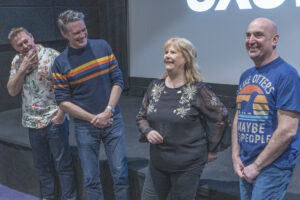
CLR: Absolutely! Everyone was laughing at the screening last night. I really enjoyed it. So I’m sure there were many technical challenges, but what stands out to you as the most difficult technical challenge that you had to wrestle with in the making of this movie?
JW: I think the biggest technical challenge for us was the fact that we both come from a wildlife-film background, but we didn’t want to make a wildlife film. Yet we had a wild animal in front of us that we could have filmed like we film snow leopards or polar bears or anything like that. And the hardest thing was to step away from the fact that this isn’t a wildlife film. We didn’t want to observe behavior. It was a story about love, a story about friendship, and it required a whole different mindset. Now, for me, that was difficult, but for Charlie, as a still photographer and as somebody who documents the world as he sees it, probably a little bit easier, but to step out of that mindset is quite a big jump for people in our position, or at least me. And I think that meant leaving the telephoto lens behind, which is something you never do in a wildlife film.
CHJ: And I think almost the entire film, bar a few shots, is within a half-mile of Billy’s house. And Jeff and I always wondered how to make something epic out of such a tiny little area. So I think that visually, that was the hardest challenge. And I think without drones, we wouldn’t have been able to pull that off. Shetland is a very flat place. There are no trees. There are no mountains. It’s just flat. So if you are filming it from the ground, it’s just flat, very hard to make it look like it deserves to look. But the moment you put a drone in the air, it suddenly transforms it. So those scenes in the middle of the film with the rowing boat at dawn and Molly swimming out to Billy in the rowing boat, I think those were the bits that we worked the hardest to get because they lifted it visually to this cinematic experience.
CLR: And you also benefited in those moments from the occasionally nice weather to give it that magic-hour glow.
CHJ: Yes. I mean, Shetland’s gray and windy most of the time, but when it’s not, it’s just extraordinary. And so those moments … and the other thing is we spent so long there that we had the serendipity of those moments and a lot of that had to do with light because Molly would only come once a day, sometimes not at all. And so if you consider how many variables have got to combine to get a moment like that when you’re in a rowing boat at dawn with extraordinary light and then Molly is there … yeah, those were the bits that were the hardest.
JW: If you were a head of production with a large crew, you would never, ever in a million years choose to work in Shetland if you wanted great light. But we’re not a large crew. We’re three people who can spend as much time watching television as we do, kind of filming things and waiting for the perfect moment. And Charlie and his team did and that’s what makes it so beautiful.
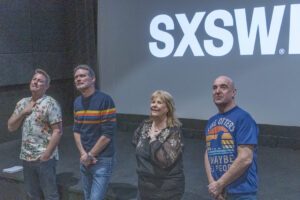
CLR: Speaking of time, how much time did you ultimately spend filming in Shetland?
CHJ: So if you lumped it all together, I was probably there for about six months, and then Johnny, who was helping me and field assisting second camera, was there a little bit longer, but it was spread out. But six months on the ground just filming is a very long filming period and I think something you could only really do, as Jeff said, with a small crew. But when you’re filming a subject like that, you don’t want a big crew. We lived together with Billy and Susan all that time in the same house. We were all having dinner every night. We were all having breakfast together. So I think it was a very lucky coincidence that we all got on really well and had that location.
JW: And Charlie and I talked about how important serendipity plays in a film like this. You need to be there to witness and to capture. We can’t script all the magic that’s in there, so you’ve got to be present. And part of the design of the project is that there’s going to be magic. We just have to be there and be present and we don’t know what that magic is, but it will come.
CLR: You talked about making it cinematic. Another thing that helps are those end sequences underwater, which take us into a whole other world that we haven’t really seen. I thought that was a really strong decision to bring us there, to add another layer. Did you film those sequences, as well, with you behind the camera?
CHJ: So I shot some of it, and then we had a guy called Bertie Gregory come and shoot some. Bertie’s actually a phenomenal camera operator and presenter on the Nat Geo channel. I’m so glad he came because I could never have got what he got. And we never go underwater in the film until then and we deliberately held back. And I think without that scene at the end, it would’ve been a much lesser film because it is a film that you think is one thing and then about every three to five minutes, we take you somewhere else you’re not expecting. And I think that was the big thing at the end: we completely take you where you’re not expecting and that’s why it keeps you watching.
CLR: Speaking of the unexpected, I really like that transition where Susan is walking Jade, following Molly, and we are then suddenly introduced to Bozo, the other otter. That was really magical, seeing them play together. I really enjoyed that. Speaking of creative decisions, when did you decide to have this back-and-forth voiceover between Susan and Billy, talking about not only Molly, but about love and other such things?
JW: It wasn’t there from the outset. We knew we were making a film about love, but we had reached the point where we were really showing how the love between a man and an otter could be visually manifested. But the extraordinary thing was that there was this other person in the background, and Susan’s such a lovely person. She was kind of catering for all the crew and being this sort of sentient, all-knowing wise woman that she is to all of us who were working on the production. And it just suddenly dawned on Charlie, I think, that he had always talked about a female narrator for the film and how we were going to pull that off. And it dawned on Charlie that she was the perfect candidate and she just brought this new level of insight and a new level and aspect of what love is. And it was perfect, I mean, absolutely perfect, but I’ll let Charlie speak to how that evolved.

CHJ: Yeah, I mean we started doing early voice recordings with Susan. She was absolutely terrible. And last night at the screening, someone came up to her from Nat Geo and said, “Your voiceover is incredible.” So many of the comments are about Susan’s voiceover and how she nailed it. And so I’m always just ribbing her about it, like, “Susan, you were so bad when we started.” I used to conduct her through a sentence because her intonations … but now, I can ping her a line now and she’ll do it. And I’m like, “Oh my God, she’s so good.” But it was great to see that blossom, and to see her take on that role was … it massively improved the film. And to Jeff’s point, as well, her insight and understanding as a wife, as a woman involved in that relationship, looking into it more objectively than Billy does, improves the emotional narratives and subplots of the film. She was really crucial to that.
CLR: You talked last night at the Q&A about the collaboration on the voiceover between you and Billy and Susan. How did that work in terms of shaping what was actually said?
CHJ: We started out by interviewing Billy very early on and we did a lot of interviews and we would record them and we would try to edit them to create a script in his words, but it didn’t work. And then we tried it with Susan. Susan was very concise, very clear, but we realized that if it was going to work, what I’d have to do is write it with them so that even though I’m putting the words down on the computer, it’s their voice. When Susan talks about Billy, that is how she sees Billy because I’ve lived with them for so long, I know exactly what they’re like.
So most of it was done like that. Probably one of the most poignant bits in the film was a verbatim voicemail message that Billy had sent me about not having children. And Sam, the editor, and I, took that voicemail message and we put it into the Avid editing program and we cut it to picture. It was so beautifully said. I could never have had the insight to say that, myself. So that was how it was done. And during the editing process, the entire film was basically voiced-over WhatsApp voicemail messages until eventually, they got in the studio and recorded the whole thing properly.
CLR: Thank you both for speaking to me. What’s next for the film? Does it have an air date on Nat Geo or …
JW: We don’t yet have a confirmed air date. It will go on to Disney+. We have a few more festivals to hit: Copenhagen, Toronto, San Francisco.
CHJ: DC.
JW: DC. So we’re hoping that there’s a bit of traction, that people love it, that maybe we even head towards theatrical. That would be a great ambition of ours, wouldn’t it? And we want more people to see it on the big screen and that’s our major ambition now.
CLR: I wish you all good things.
CHJ/JW: Thank you!
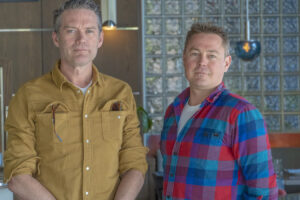


Thank you for this interview! These were exactly the same questions I was wondering during the movie. It’s gorgeous and sweet!
Thanks for reading the interview! And yes, what a lovely film it is. Glad you enjoyed checking out their response to my questions.
Bill and Molly: A Otter Love Story—- What a magical story, beautifully told and filmed. I was thrilled to find this interview and it answered all of the questions I had: how did the camera people show up at the right time? How this? etc. Thank you for sharing this incredible story and for it having a nice ending when usually they don’t. I love animals, have a household of adopted rescued animals who can’t be put into the wild and a relationship with a wild animal would be a dream come true!’
Fantastic interview! I wanted to know how this gorgeous movie was made, and got my answers. Thank you for this article and this special, endearing movie.
Thank you for bringing the healing power of nature to the viewers in a most extraordinarily beautiful film. I kept noticing the thumbnail and felt compelled to make time to watch it, and am the better for it. Although most humans never will directly experience such enriching relationships, the documentary allows us to share some of the best moments of this family’s interspecies attachments and expansion through the wonders of love and beauty.
I’m so glad you took the time to watch and that you reacted to the movie in the way you did. It is a lovely story, indeed!
Completely by accident I found this documentary today and I was spellbound watching. The story alone was fabulous, but then the amazing shots of the Shetlands left me awestruck. Its a documentary that gives you a happy, fulfilled feeling of life.
I’m so glad you found the film! I loved it (as you could tell). Molly is adorable and the Shetlands are, indeed, quite beautiful.
Thank you for this interview. I found the insight into how the film came together very compelling. I loved the film but I need to watch it again without the feeling of dread I had the first time. I was shattered by the ending of “Ring of Bright Water” (spoiler alert: the otter is killed), and was steeling myself for a similar ending in “Billy and Molly.” What a relief to have a sweet and love-affirming ending. I’ll watch it again feeling happily relaxed.
I’m so glad you found this interview to be informative, Mimi. And I completely know what you mean about the anticipatory dread one can feel watching a nature documentary. It’s how I felt during “My Octopus Teacher.” Hope you get to watch “Billy & Molly” again soon!